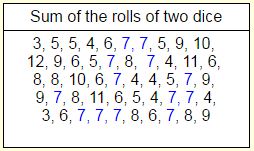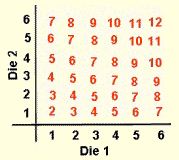Theoretical vs Empirical Probability
Probability describes the chance that an uncertain event will occur.
Empirical Probability of an event is an “estimate” that the event will happen based on how often the event occurs after collecting data or running an experiment (in a large number of trials). It is based specifically on direct observations or experiences.
Empirical Probability Formula

P(E) = probability that an event, E, will occur.
top = number of ways the specific event occurs.
bottom = number of ways the experiment could occur.
Example: A survey was conducted to determine students’ favorite breeds of dogs. Each student chose only one breed.
| Dog | Collie | Spaniel | Lab | Boxer | PitBull | Other |
| # | 10 | 15 | 35 | 8 | 5 | 12 |
What is the probability that a student’s favorite dog breed is Lab?
Answer: 35 out of the 85 students chose Lab. The probability is \(\frac { 35 }{ 85 } =\frac { 7 }{ 17 } \).
Theoretical Probability of an event is the number of ways that the event can occur, divided by the total number of outcomes. It is finding the probability of events that come from a sample space of known equally likely outcomes.
Theoretical Probability Formula

P(E) = probability that an event, E, will occur.
n(E) = number of equally likely outcomes of E.
n(S) = number of equally likely outcomes of sample space S.
Example 1: Find the probability of rolling a six on a fair die.
Answer: The sample space for rolling is die is 6 equally likely results: {1, 2, 3, 4, 5, 6}.
The probability of rolling a 6 is one out of 6 or .
Example 2: Find the probability of tossing a fair die and getting an odd number.
Answer:
event E: tossing an odd number
outcomes in E: {1, 3, 5}
sample space S: {1, 2, 3, 4, 5, 6}

Comparing Empirical and Theoretical Probabilities:
Karen and Jason roll two dice 50 times and record their results in the accompanying chart.
(1) What is their empirical probability of rolling a 7?
(2) What is the theoretical probability of rolling a 7?
(3) How do the empirical and theoretical probabilities compare?

Solution:

(1) Empirical probability (experimental probability or observed probability) is 13/50 = 26%.
(2) Theoretical probability (based upon what is possible when working with two dice) = 6/36 = 1/6 = 16.7% (check out the table at the right of possible sums when rolling two dice).
(3) Karen and Jason rolled more 7’s than would be expected theoretically.
Vocabulary to keep in mind:
Biased: one result has a better chance of happening than another result.
Unbiased (fair) : each result has an equal chance of happening.
